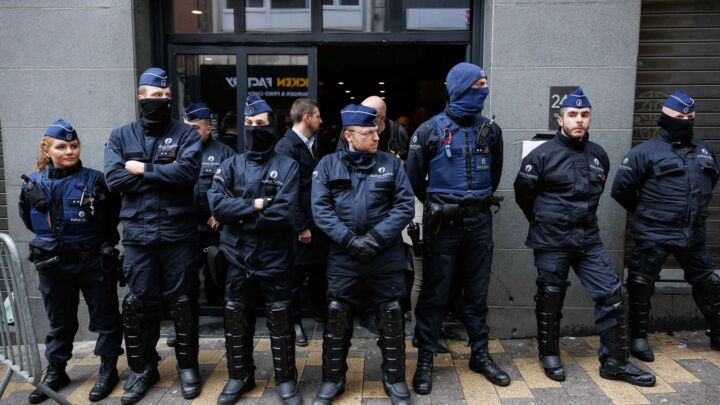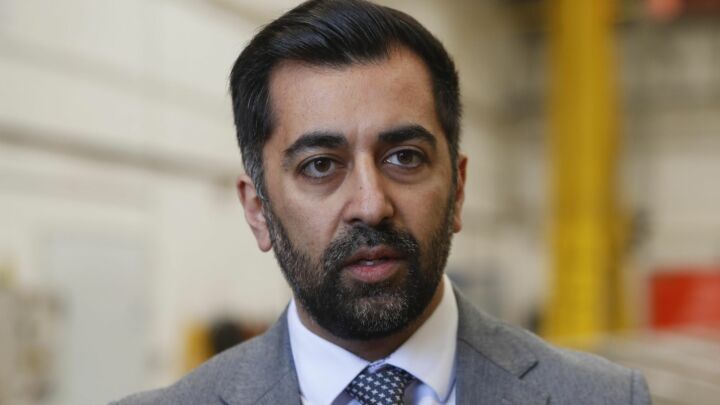Who’s afraid of Islamophobia?
Despite dire predictions, there was no anti-Muslim pogrom after 11 September.

‘All Muslims are now terrorists and, it seems, fair game. So we brace ourselves again for a period of bile and beatings and hate mail…. Islamophobia will once more erupt worldwide and be legitimised by some political leaders. It is okay to hate a Muslim again.’ (1)
So wrote one UK columnist immediately after 11 September. Across the world, there were forecasts of a virulent anti-Muslim reaction. Political leaders in Europe and America rushed to stem the threat, quoting from the Koran and insisting that the war on terror was not a war against Islam. Police guarded mosques from attack.
Ten months on, there is little sign of the predicted wave of bile, beatings and hate mail. So did the hasty measures nip the phobia in the bud, or was there no phobia in the first place?
The evidence shows that, if there has been some kind of new anti-Muslim reaction after 11 September, it has been relatively minor. ‘There isn’t really evidence of an increase [in assaults against Muslims]’, a spokesperson from London’s Metropolitan Police told me.
Even in the USA, the most violent Western society, serious attacks have been isolated incidents rather than pogroms. In Arizona, a Sikh gas station owner was shot dead; a Pakistani Muslim was killed in Dallas; and a Christian Egyptian-born grocer was shot dead in suburban Phoenix (2).
The European Monitoring Centre on Racism and Xenophobia (EUMC) recently produced a report documenting the anti-Islamic reaction in European states in the four months after 11 September (3). Although the report was headlined as showing a ‘major explosion’ in anti-Muslim sentiment, the attached documentation told a rather different story. Out of the physical assaults on Muslims that had been reported in the UK press, there were around 15 cases of serious physical violence, and a similar number of damage to property. There were a handful of other cases of Muslims being chased and threatened with violence, Muslim women having their headscarves torn off, and a larger number of cases of Muslims receiving hate mail or being threatened verbally.
Even the UK Islamic Human Rights Commission, an organisation with a somewhat partial agenda, could only claim 52 incidents of physical violence – and these ranged ‘from pushing, shoving and spitting to serious attacks leading to hospitalisation’. The commission also reported 36 incidents of criminal damage – mainly in the form of attacks on mosques and Islamic centres (4).
While all these incidents should be condemned, they affected a very small number of the two million Muslims living in the UK. And in many of the cases there is uncertainty about whether an individual was attacked because he or she was Muslim, as motivation for attacks is not always clear.
Just after 11 September, UK Home Office minister John Denham promised that the government would act to cut out the ‘cancer of Islamophobia’. There were meetings between members of the Muslim community and politicians, aimed at promoting cultural dialogue. UK prime minister Tony Blair repeatedly stated that the Afghan war was ‘not against Islam’, a message that the his spokesman Alastair Campbell got into an editorial in the UK tabloid the Sun. Police forces were put on high alert, and met with Muslim community groups to reassure them that action was being taken.
But the extraordinary thing was that this attempt to stem Islamophobia occurred before anything had happened. It was a rush to head off a wave that was not on the horizon and that never came. It seems that Western elites were as fearful of a strong anti-Muslim reaction from their populations as they were of the terrorist threat itself. This is very different to the way that elites of the past consciously mobilised popular xenophobia against the enemy (think of the propaganda around the Second World War, Vietnam, or the Falklands War).
The ‘don’t attack Muslims’ call showed a profound distrust of the public – a fear that base sentiments lurk under the surface, only requiring a spark to be unleashed. It also showed that the new elites are deeply uncomfortable about the ideas their forebears relied upon for their legitimacy: ideas of Western superiority, nationalism and race.
So ‘Islamophobia’ as a popular anti-Muslim racism did not happen. But an examination of many of the publications and statements about Islamophobia suggests that this is not what the term meant in the first place. Instead, ‘Islamophobia’ is used to refer to a huge range of incidents, many of which are relatively minor – though they are often presented in sensational terms.
The press release for the EUMC report stated that: ‘Muslims became indiscriminate victims of an increased and prolonged upsurge of both verbal and physical attacks following the events of 11 September’, and that Muslim women had been ‘routinely abused and attacked’ (5). But one case documented by the EUMC was that of Mohammed Saddique, a shopkeeper from Oldham who was regularly called ‘Osama’ by his suppliers (even though Mr Saddique told the Guardian, ‘I think they’re taking the Mickey and I prefer to treat it as a joke’ (6)). Another was of two girls sitting outside a café in London who were harassed by a drunk, homeless man who said ‘Islam is evil’, ‘you’re evil’.
A representative from the UK organisation Forum Against Islamophobia and Racism (FAIR) told me that after 11 September their previous five calls a month increased to around 30 calls a month. But these included all kinds of incidents: ‘People have been targeted in school – a girl wearing Islamic dress was told that it wasn’t acceptable.’ Another example was: ‘An eight-year-old child mentioned bin Laden. He was kept in detention and questioned by six members of staff, who were really trying to intimidate him.’
Christopher Allen, co-author of the EUMC report, explained that this low-level abuse was actually mainly what Islamophobia was mainly about. ‘It manifested itself in quite basic and low-level ways. There were very few serious attacks or serious incidents. It was a grassroots-level thing: children in school were abused, Muslim women were abused. It wasn’t major or overwhelming, but affected Muslims’ normal everyday lives. Wherever they were going they encountered hostility – a woman gets on Tube and everybody looks at her, and thinks “Is she going to do something?”‘.
These incidents are all unpleasant, but to link them together as representing a serious anti-Muslim prejudice is to lose sight of what real racism is. Isolated incidents, many of which had little effect on the victims, are very different from a virulent pattern of abuse and hate. ‘Islamophobia’, in this regard, is little more than an over-sensitivity about the way people relate to each other on an everyday level.
Indeed, it is probably all the hype about Islamophobia after 11 September that encouraged many Muslims to report such minor incidents in the first place. The dire predictions of an anti-Muslim reaction fostered a touchiness on the part of ordinary Muslims, so that their children’s bad experiences at school became part of European anti-racism reports.
Interestingly, race-relations campaigns around Islamophobia came into being at a time when racism against Muslim communities was arguably past its peak. In the 1980s and early 1990s there was a popular anti-Muslim prejudice, reflected in the ‘mad mullahs’ stereotypes. Yet the term Islamophobia was not used in policy in the UK until 1997, when the race relations think-tank the Runnymede Trust published a report, Islamophobia: A Challenge For Us All.
This report talked about a rising ‘anti-Muslim prejudice’ that needed addressing in policy. But the section titled ‘The nature of Islamophobia’ suggests a very broad notion of prejudice – examples of Islamophobia included people seeing Islam as inferior to the West, rather than just distinctively different; seeing Islam as monolithic and static, rather than diverse and progressive; seeing Islam as an enemy, rather than a partner to cooperate with (7). This also seemed to be founded on an over-sensitivity, an attempt to stem any kind of criticism of Islam. Rather than engage Muslims in debate, non-Muslims are supposed to tiptoe around them, for fear of causing offence.
Since 11 September we have seen how this attitude can stifle discussion. First, there was Italian prime minister Silvio Berlusconi, who was lambasted for daring to suggest that Western civilisation was superior to Islam. Then, UK Europe minister Peter Hain’s statement that Britain’s Muslim community is ‘isolationist’ was greeted with accusations that he was Islamophobic.
Also underlying the Runnymede Trust’s idea of Islamophobia is an aversion to strong Muslim belief. In the 1997 report, Islam is represented as a cutesy religion of peace and diversity, that I am sure many Muslims – who, like other believers, tend to think of their religion as the truth and the light – would object to.
This hype about Islamophobia cannot be good for any of us. It encourages Muslims to live in fear of attack, and to blow everyday incidents out of proportion. It also stifles debate and engagement between Muslims and non-Muslims.
Perhaps Islamophobia does need to be cut out of British society – the concept, that is, not the cancer.
Read on:
spiked-issue: Race
(1) Yasmin Alibhai-Brown: This fireball of fear and loathing, Independent, 14 September 2001
(2) USA Today, 19 September 2001
(3) See the whole EUMC report and the UK country report
(4) UK country report
(5) Press release, 23 May 2002
(6) Muslims fear racist backlash in town scarred by riots , Guardian, 24 October 2001
(7) The Nature of Islamophobia, from Islamophobia: A Challenge For Us All, Runnymede Trust, 1997
To enquire about republishing spiked’s content, a right to reply or to request a correction, please contact the managing editor, Viv Regan.








Comments
Want to join the conversation?
Only spiked supporters and patrons, who donate regularly to us, can comment on our articles.